Rob Jones of Romor Designs returned to Japan this February to re-immerse himself in traditional Japanese textile techniques under the guidance of his friend and mentor and textiles guru, Bryan Whitehead.
Day 1
Rob and Bryan visited the Kioi Gallery Edo Ise-Katagami Stencil museum in Chiyoda-ku to check out the stunning persimmon dyed stencils from the Edo through to the Showa period. As the World’s only Ise-Katagami collection, the museum boasts a collection of over 5,000 stencils.
The museum shop sold a number of small hand cut modern stencils which Rob has brought back to the UK for his students to use in his new Katazome (indigo dyed) stencilling class.
Rob stayed at Bryan’s charming farmhouse in Fujino, one of Japan’s 100 most scenic villages.
Rob and Bryan visited the Kioi Gallery Edo Ise-Katagami Stencil museum in Chiyoda-ku to check out the stunning persimmon dyed stencils from the Edo through to the Showa period. As the World’s only Ise-Katagami collection, the museum boasts a collection of over 5,000 stencils.
The museum shop sold a number of small hand cut modern stencils which Rob has brought back to the UK for his students to use in his new Katazome (indigo dyed) stencilling class.
Rob stayed at Bryan’s charming farmhouse in Fujino, one of Japan’s 100 most scenic villages.
Day 2
On a beautiful blue sky day Bryan took Rob over to see Yazaki, a qualified master kimono maker. Yazaki will be coming to West Dean College in West Sussex to teach in 2019 and is trying to perfect her English before then.
Bryan has been in the process of making two indigo dyed fireman’s jackets lined with persimmon dyed vintage cotton and was attaching the sleeves of the child’s version. In Japan the creation of a kimono is very precise and was decided a thousand years ago. It’s actually a very architectural process where every measurement and seam allowance is prescribed and very precisely measured.
Kimono makers use a very neat mini iron called a kote; the top of which leaves semi-permanent creases meaning you don’t need to use chalk or marker pens.
On a beautiful blue sky day Bryan took Rob over to see Yazaki, a qualified master kimono maker. Yazaki will be coming to West Dean College in West Sussex to teach in 2019 and is trying to perfect her English before then.
Bryan has been in the process of making two indigo dyed fireman’s jackets lined with persimmon dyed vintage cotton and was attaching the sleeves of the child’s version. In Japan the creation of a kimono is very precise and was decided a thousand years ago. It’s actually a very architectural process where every measurement and seam allowance is prescribed and very precisely measured.
Kimono makers use a very neat mini iron called a kote; the top of which leaves semi-permanent creases meaning you don’t need to use chalk or marker pens.
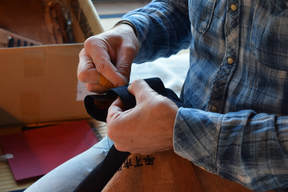
Making beautiful fabric by hand is inevitably a long process so wasting anything doesn’t make sense. It’s why cultures around the world that make their fabrics avoid cutting it up as much as possible. Think Japanese kimono silk, Indian saris and, closer to home Scottish and Irish kilts.
Day 3
Bryan gave Rob a list of places to visit in the Omote Sando, Tokyo’s Designer district. Rob ventured off the main drag to find independent designers and antiques stores around every corner. His first stop was Gallery Kawano, a veritable treasure trove of kimono silk and cotton offcuts including haori jackets, obi belts and full kimonos. He rummaged through huge piles of silk rolls in search of the good stuff and was eventually rewarded with three good pieces, including two lovely bits of genuine shibori (a lot of later pieces are prints of shibori patterns).
At the second-hand clothes store, Chicago, Rob discovered a whole section of silk and cotton kimonos at very reasonable prices. Rob was delighted to find a shibori kimono (perfect for a customer he’d been asked to source one for) and a stunning jacket with a distorted traditional hemp leaf pattern that Rob is going to keep for inspiration!
His third destination was the Ishii collection. Mr Ishii was charming and patient as Rob sorted through his entire (extensive!) Katagami stencil collection. Rob bought so many that Mr Ishii gave him a hardback folio to take them all home in. Next, Rob visited Morita Antiques where the owner and his wife stock a huge range of boro, woven cotton and indigo, kimono silk, art objects and a lovely art textiles book they wrote themselves.
Bryan gave Rob a list of places to visit in the Omote Sando, Tokyo’s Designer district. Rob ventured off the main drag to find independent designers and antiques stores around every corner. His first stop was Gallery Kawano, a veritable treasure trove of kimono silk and cotton offcuts including haori jackets, obi belts and full kimonos. He rummaged through huge piles of silk rolls in search of the good stuff and was eventually rewarded with three good pieces, including two lovely bits of genuine shibori (a lot of later pieces are prints of shibori patterns).
At the second-hand clothes store, Chicago, Rob discovered a whole section of silk and cotton kimonos at very reasonable prices. Rob was delighted to find a shibori kimono (perfect for a customer he’d been asked to source one for) and a stunning jacket with a distorted traditional hemp leaf pattern that Rob is going to keep for inspiration!
His third destination was the Ishii collection. Mr Ishii was charming and patient as Rob sorted through his entire (extensive!) Katagami stencil collection. Rob bought so many that Mr Ishii gave him a hardback folio to take them all home in. Next, Rob visited Morita Antiques where the owner and his wife stock a huge range of boro, woven cotton and indigo, kimono silk, art objects and a lovely art textiles book they wrote themselves.
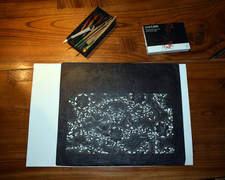
Day 4
Rob started the day visiting the three Kapital shops in Shibuya. Kapital is perhaps the world’s coolest and chicest denim brand, combining innovative cuts with the best Japanese indigo dyed denim and old and newly made boro textiles to make beautiful contemporary and desirable items.
The rest of the day was spent visiting Nippori, Tokyo’s fabric district, and getting stencilling and indigo supplies from Seiwa. Nippori is a dangerous place to visit for the textiles fan! Full of small and large outlets selling anything from bolts of vintage and modern cotton through to obi belts, whole kimono and everything in between. Rob succumbed and bought a number of items including two nice haori jackets, obi belts, vintage silk, fine cotton and soft cotton fabric.
He picked up high quality Japanese indigo and chems and more stencilling kits for his new class, including persimmon paper to cut, tenterhooks, paper cones for freehand work, rice paste (made up and component parts), pre-reduced indigo, paint brushes for applying sumi ink, fine mesh and creosote to attach to the back of cut stencils and a couple of great books - Traditional Japanese Stencil Designs and The Complete Japanese Tie-Dyeing, which is actually a fantastic reference book for shibori techniques with step by step pictures.
Rob started the day visiting the three Kapital shops in Shibuya. Kapital is perhaps the world’s coolest and chicest denim brand, combining innovative cuts with the best Japanese indigo dyed denim and old and newly made boro textiles to make beautiful contemporary and desirable items.
The rest of the day was spent visiting Nippori, Tokyo’s fabric district, and getting stencilling and indigo supplies from Seiwa. Nippori is a dangerous place to visit for the textiles fan! Full of small and large outlets selling anything from bolts of vintage and modern cotton through to obi belts, whole kimono and everything in between. Rob succumbed and bought a number of items including two nice haori jackets, obi belts, vintage silk, fine cotton and soft cotton fabric.
He picked up high quality Japanese indigo and chems and more stencilling kits for his new class, including persimmon paper to cut, tenterhooks, paper cones for freehand work, rice paste (made up and component parts), pre-reduced indigo, paint brushes for applying sumi ink, fine mesh and creosote to attach to the back of cut stencils and a couple of great books - Traditional Japanese Stencil Designs and The Complete Japanese Tie-Dyeing, which is actually a fantastic reference book for shibori techniques with step by step pictures.
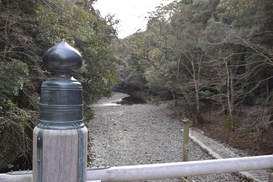
Day 5
Rob headed off early to Ise in the South West of Japan, home to Katagami stencilling and sumi ink production and Japan’s most famous Shinto shrine. It took two local trains to get to the Shinkansen bullet train in Tokyo which made short work of the 280 mile trip getting him there in an hour and 40 minutes!
The Ise Katagami stencil museum and the Ise paper museum both had some stunning stencils. The stencil museum has a Dogubori (tool cut stencil) master who teaches there and some of his work is on display, including examples on silk and cotton shown next to the stencils themselves. Rob was very fortunate to be allowed to briefly sit in on the Dogoburi master’s class. He’d trained for 40 years to become a master but the students had only been doing it for a few years, 10 is typical to be considered any good! There are a number of different specialisms within Katagami stencilling and Dogubori is the one focused on using special tools to cut little shapes such as hearts, triangles, etc. Students have to make their own tools out of thin steel sheet so there’s a lot more to it than just cutting the stencils.
Rob made his way over to the paper museum which was much larger and had used the stencils in creative ways, such as for lampshades and even in front of panes of glass in windows. Having seen an old lady being given her own stencil to cut, Rob asked if he could do one too and cut a small one of a bamboo leaf. Rob also managed to stock up on persimmon paper and bought a few more stencils for his classes.
Rob headed off early to Ise in the South West of Japan, home to Katagami stencilling and sumi ink production and Japan’s most famous Shinto shrine. It took two local trains to get to the Shinkansen bullet train in Tokyo which made short work of the 280 mile trip getting him there in an hour and 40 minutes!
The Ise Katagami stencil museum and the Ise paper museum both had some stunning stencils. The stencil museum has a Dogubori (tool cut stencil) master who teaches there and some of his work is on display, including examples on silk and cotton shown next to the stencils themselves. Rob was very fortunate to be allowed to briefly sit in on the Dogoburi master’s class. He’d trained for 40 years to become a master but the students had only been doing it for a few years, 10 is typical to be considered any good! There are a number of different specialisms within Katagami stencilling and Dogubori is the one focused on using special tools to cut little shapes such as hearts, triangles, etc. Students have to make their own tools out of thin steel sheet so there’s a lot more to it than just cutting the stencils.
Rob made his way over to the paper museum which was much larger and had used the stencils in creative ways, such as for lampshades and even in front of panes of glass in windows. Having seen an old lady being given her own stencil to cut, Rob asked if he could do one too and cut a small one of a bamboo leaf. Rob also managed to stock up on persimmon paper and bought a few more stencils for his classes.
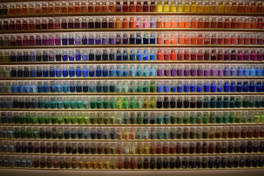
Day 6
Rob spent some of the day sightseeing and visited Kotaijingu Naiku - the largest and most venerated Shinto shrine in Japan, dedicated to Amaterasu-Omikai, the ancestral kami (Shinto deity) of the imperial family.
Arriving back in Tokyo and finding himself close to Tennozu Isle, Rob decided to follow another of Bryan’s recommendations and travel on the Tokyo monorail to get to Pigment, a stunning art shop with every colour pigment/lake you could want. The space is fantastic and the range of colours kaleidoscopic. Rob bought some rose madder (bright red) to add to the rice paste for stencilling (it shows up better in the paste) and some pine charcoal in a rich black (used in sumi painting and as a base for indigo dyeing).
Rob spent some of the day sightseeing and visited Kotaijingu Naiku - the largest and most venerated Shinto shrine in Japan, dedicated to Amaterasu-Omikai, the ancestral kami (Shinto deity) of the imperial family.
Arriving back in Tokyo and finding himself close to Tennozu Isle, Rob decided to follow another of Bryan’s recommendations and travel on the Tokyo monorail to get to Pigment, a stunning art shop with every colour pigment/lake you could want. The space is fantastic and the range of colours kaleidoscopic. Rob bought some rose madder (bright red) to add to the rice paste for stencilling (it shows up better in the paste) and some pine charcoal in a rich black (used in sumi painting and as a base for indigo dyeing).
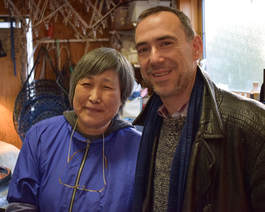
Day 7
Rob and Bryan visited the Sashiko museum in Hinohara. Part of it was originally a 200-year old horse breeders’ house in Nii gata - northern Japan which was moved to Hinohara in the mid 80s. It is full of Sashiko and other art objects, including a large collection of Kokeshi (Japanese wooden dildos!). They sell some beautiful hand-dyed natural dyed Sashiko threads which Rob bought and a piece of beautiful light blue indigo dyed cotton. From there we visited the house of Yuko Morita, who Bryan met not long after he moved to Japan. Yuko is a master of fermented indigo dyeing, a particularly tricky form, requiring constant vigilance in the preparation and maintenance of the 4 vats she uses throughout the year. The vats are huge and have to be filled slowly with a combination of ash water (which she makes herself), rice bran (which is what ferments) and fermented Japanese indigo. The 100 litre vats take around 10 days to fill and ferment with more ingredients being added each day until they are ready. Apparently an unspecified amount of saki rice wine is also added at the beginning with a prayer to the gods for a good vat. Yuko dyes fabric for others as well as her own work, including thread, shibori and Katagami stencilled pieces.
Rob and Bryan visited the Sashiko museum in Hinohara. Part of it was originally a 200-year old horse breeders’ house in Nii gata - northern Japan which was moved to Hinohara in the mid 80s. It is full of Sashiko and other art objects, including a large collection of Kokeshi (Japanese wooden dildos!). They sell some beautiful hand-dyed natural dyed Sashiko threads which Rob bought and a piece of beautiful light blue indigo dyed cotton. From there we visited the house of Yuko Morita, who Bryan met not long after he moved to Japan. Yuko is a master of fermented indigo dyeing, a particularly tricky form, requiring constant vigilance in the preparation and maintenance of the 4 vats she uses throughout the year. The vats are huge and have to be filled slowly with a combination of ash water (which she makes herself), rice bran (which is what ferments) and fermented Japanese indigo. The 100 litre vats take around 10 days to fill and ferment with more ingredients being added each day until they are ready. Apparently an unspecified amount of saki rice wine is also added at the beginning with a prayer to the gods for a good vat. Yuko dyes fabric for others as well as her own work, including thread, shibori and Katagami stencilled pieces.
Day 8
Rob and Bryan spent the morning picking indigo seeds from the field near the house and then Bryan showed Rob how to fix the silk to the back of his stencils with a sort of lacquer and netting. It’s messy, sticky work but will mean his stencils will last a lot longer.
Rob also made some with just netting which he can put over older stencils to protect them and use for leaf stencils.
Rob and Bryan spent the morning picking indigo seeds from the field near the house and then Bryan showed Rob how to fix the silk to the back of his stencils with a sort of lacquer and netting. It’s messy, sticky work but will mean his stencils will last a lot longer.
Rob also made some with just netting which he can put over older stencils to protect them and use for leaf stencils.
Back in the UK
Rob is now creating textiles using Katagami stencilling techniques. He is making his own stencils as well as using those he picked up in Japan.
If you would like to try your hand at Japanese Shibori and Katagami techniques, check out Rob's workshops by clicking on the link below.
Rob is now creating textiles using Katagami stencilling techniques. He is making his own stencils as well as using those he picked up in Japan.
If you would like to try your hand at Japanese Shibori and Katagami techniques, check out Rob's workshops by clicking on the link below.
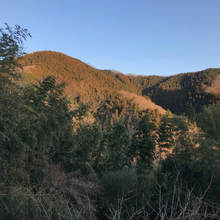
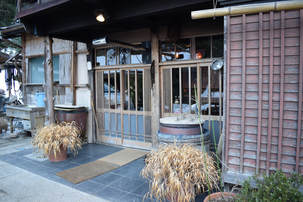
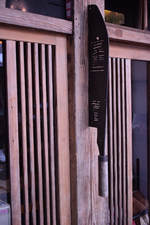
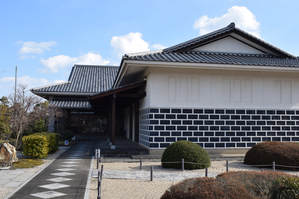
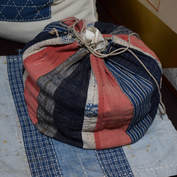
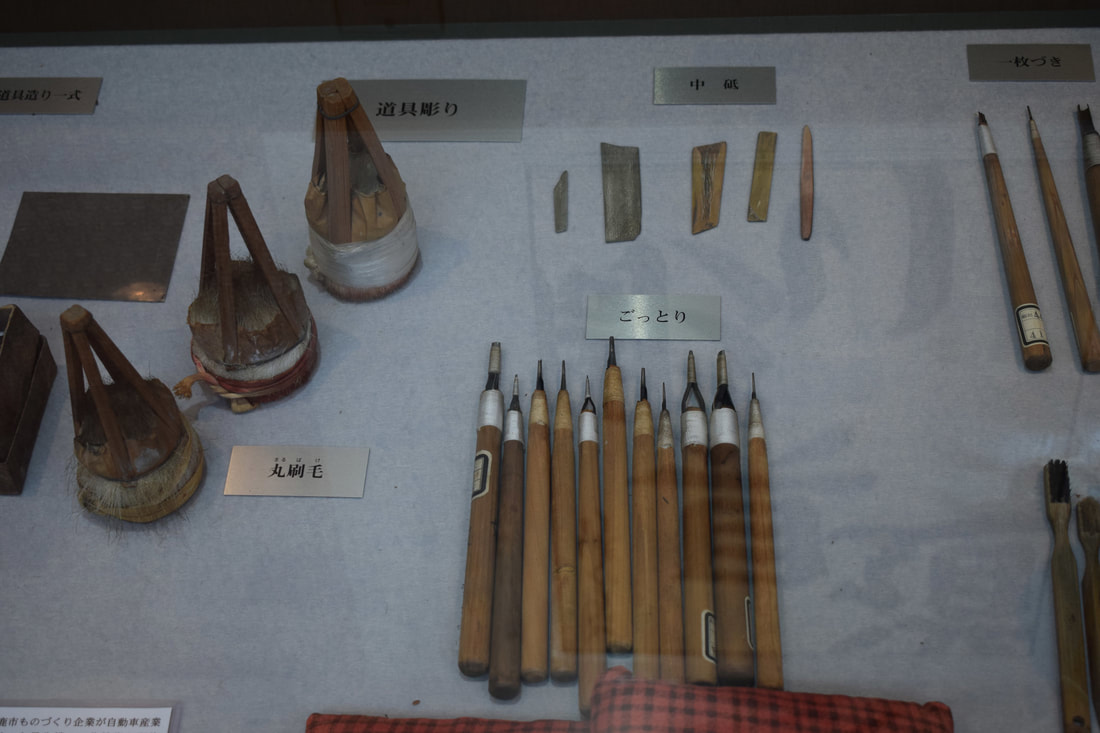
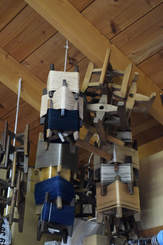
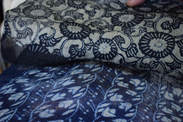
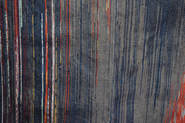
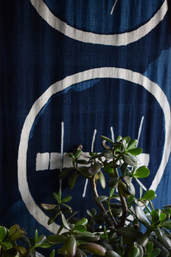
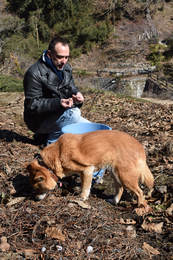
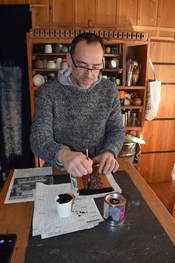
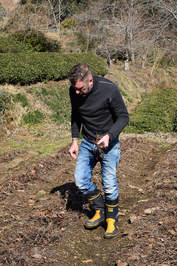
 RSS Feed
RSS Feed
